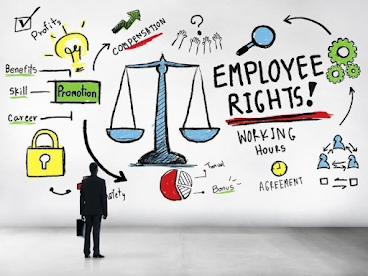Navigating Labor Laws: Ensuring HR Compliance in a Changing Legal Landscape
Staying
compliant with labor laws has become a critical challenge for Human Resources
(HR) professionals in today's rapidly changing business world. The legal
landscape governing the employer-employee relationship is constantly changing,
making it critical for HR teams to effectively navigate these changes. Failure
to do so may result in legal penalties, reputational harm, and business
disruptions. In this article, we will look at the strategies that human
resource professionals can use to ensure compliance with labor laws in the face
of a changing legal landscape.
1. Stay Informed and Updated
The
first step in ensuring HR compliance is to stay current on labor law developments.
Wage and hour regulations, anti-discrimination laws, and employee rights are
all subject to frequent change under federal, state, and local laws.
Subscribing to legal newsletters, attending seminars, and using trustworthy
online resources are all effective ways to stay current.
2. Conduct Regular Audits
Regular compliance audits are required to identify potential gaps in HR practices. Audits can assist in identifying inconsistencies in areas such as employee classification, payroll practices, and record-keeping. HR departments can avoid legal ramifications by proactively identifying and resolving issues.
3. Develop Comprehensive Policies
HR
compliance begins with well-crafted policies that are in accordance with the
most recent labor laws. Creating a comprehensive employee handbook outlining
workplace policies, procedures, and employee rights can be a valuable resource
for both HR professionals and employees.
4. Provide Training
Education
is an effective tool for ensuring compliance. HR professionals should hold
training sessions on a regular basis for both management and employees. Topics
covered in these sessions may include harassment prevention, workplace safety,
and employee classification. Inadvertent violations can be avoided by ensuring
that everyone is aware of their rights and responsibilities.
5. Collaborate with Legal Experts
Due
to the complexities of labor laws, collaboration with legal experts is
required. When dealing with complex legal issues, HR professionals can benefit from
establishing relationships with employment attorneys. Legal experts can assist
in interpreting new laws, assessing their impact on the organization, and
recommending necessary changes.
6. Adapt to Remote Work Challenges
The
rise of remote work has created new challenges for human resource compliance.
Adhering to labor laws, such as accurately tracking work hours and ensuring
proper classification of remote workers, necessitates creative solutions. HR
departments should collaborate closely with legal counsel to adapt policies and
procedures to the remote work environment.
7. Embrace Technology
HR
professionals can use technology to help them streamline their compliance
efforts. HR management software can help you keep accurate records, track employee
hours, and automate compliance-related tasks. Automation reduces the
possibility of human error and ensures that labor laws are followed
consistently.
8. Maintain a Culture of Compliance
It
is critical to instill a compliance culture throughout the organization.
Employees are more likely to follow policies and procedures when compliance
becomes an integral part of the company's values. HR professionals can set a
good example by demonstrating the significance of adhering to labor laws and ethical
business practices.
Navigating
labor laws and maintaining HR compliance is a continuous process that
necessitates vigilance, adaptability, and proactive measures. To facilitate
compliance efforts, HR professionals must stay informed about changes in labor
laws, conduct regular audits, collaborate with legal experts, and leverage
technology. HR departments can protect their organizations from legal risks,
build a positive reputation, and create a fair and ethical work environment for
employees by prioritizing compliance and fostering a culture of adherence to
labor laws.
https://www.brainzmagazine.com/post/enhancing-hr-compliance-how-to-ensure-accuracy-and-security
References
Wertz, J. (2018). Navigating Labor Law: Here’s What
Startups Need To Know. Forbes. [online] 30 Apr. Available at: https://www.forbes.com/sites/jiawertz/2018/04/29/navigating-labor-law-what-startups-need-to-know/
[Accessed 6 Nov 2023].
Desire, L. (2023). Legal Considerations for
Remote Work: Navigating Employment Laws in a Digital Era. [online] Legal
Desire Media and Insights. Available at: https://legaldesire.com/legal-considerations-for-remote-work-navigating-employment-laws-in-a-digital-era/
[Accessed 11 Nov. 2023].
SHRM-SCP, M.M.C., J. D. (2018). Navigating
Employment Law in the Gig Economy. [online] SHRM. Available at: https://www.shrm.org/hr-today/news/hr-magazine/0618/pages/navigating-employment-law-in-the-gig-economy.aspx.
Hrci Marketing. (n.d.). 3 Strategies for
Navigating Global Labor Regulations. [online] Available at: https://www.hrci.org/community/blogs-and-announcements/hr-leads-business-blog/hr-leads-business/2022/02/14/3-strategies-for-navigating-global-labor-regulations
.
Todd, S. (n.d.). Strategies for Staying
Compliant with Employment Regulations: Navigating Labor Laws. [online]
Open Sourced Workplace. Available at: https://opensourcedworkplace.com/news/hr-news/strategies-for-staying-compliant-with-employment-regulations-navigating-labor-laws
[Accessed 11 Nov. 2023].



Very good post.Clearly says the importance of keeping updated on HR legal reforms.Nicely constructed .
ReplyDeleteGood job.